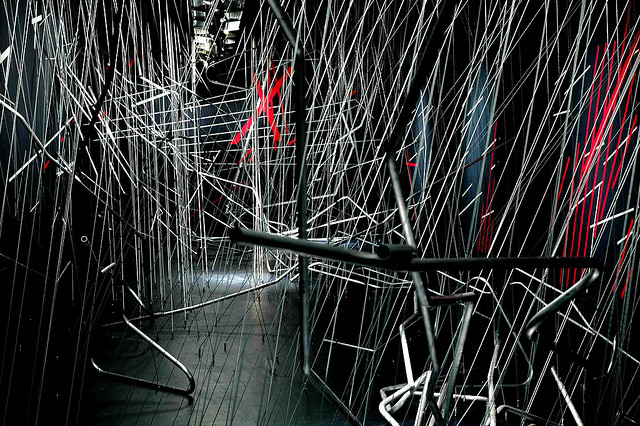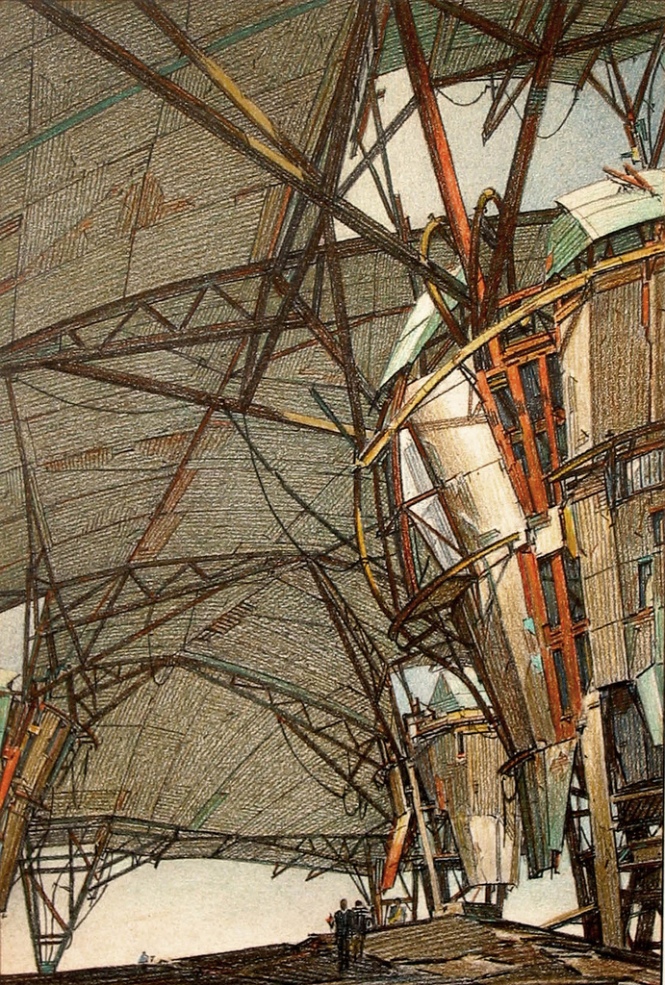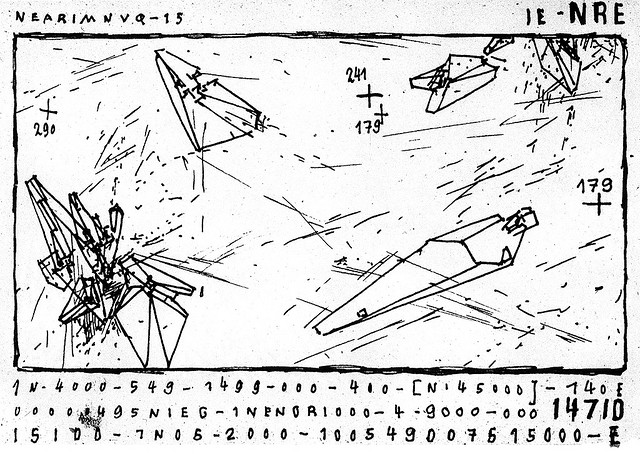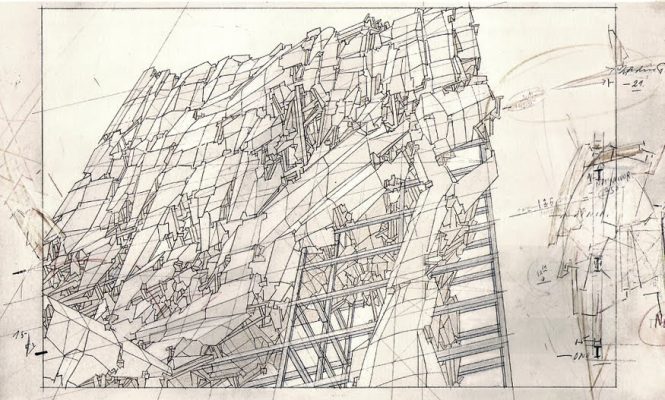New York, November 30, 2012. Exactly one month ago, on October 30th, during the arrival of hurricane Sandy upon Gotham City, one of the most imaginative and fiercely anti-authoritarian architects and theoreticians of our time, the inimitable Lebbeus Woods passed away. For those who have never personally met Woods or been acquainted with his work, you still may have inadvertently seen his concepts – whether it was in the sets of the movie Alien 3 or on the cover of science fiction-writer Arthur C. Clarke’s book, or his work plagiarized in the brilliant Terry Gillian film 12 Monkeys. But regardless of his contribution to futuristic imagination, what made Woods so unique was his “non-conformist anti-starchitecture” way of thinking and working, and “resisting the temptations of money and fame.” (source: http://hyperallergic.com/59590/remembering-radical-theoretical-architect-lebbeus-woods/)
Just a day before his death, I had the pleasure of running into and conversing with one of Labbeus’ oldest friends architect Steven Holl, who invited me to his talk at the Cooper Union to be moderated by another favourite writer/philosopher/professor of mine Sanford Kwinter. Little did Holl know on that evening that his completely sold-out and house full lecture would turn out to be a touching tribute in memory of his friend.
As written in the New York Art & Architecture blogazine Hypperallergic:
Last month, as New York City was overwhelmed by Hurricane Sandy, one of the world’s foremost architects passed away in the darkened and chaotic city that was almost overcome by nature. It was a cosmic confluence — environmental mayhem coincided with the last breath of a great creative individual who was always dreaming for more, and embracing an out-of-control world.
Lebbeus Woods and Christoph a. Kumpusch discussing Martin Lodman work at Columbia’s GSAPP Final review of Kumpusch-Studio. (photo by Siting Zhang)
Defiantly non-conformist, anti-starchitecture architect Lebbeus Woods died on Tuesday, October 30. He was 72. Through a lifetime of work, the vast majority of which only exists on paper, Woods challenged the architectural establishment, railing against boring buildings and resisting the temptations of money and fame that turned architects like Zaha Hadid and Rem Koolhaas into celebrities.
“With the triumph of liberal democracy and laissez-faire capitalism, the conversation came to an end. Everyone wanted to build, which left less room for certain kinds of architecture,” Woods told Nicolai Ourrossof of the New York Times when describing the political situation driving an anodyne architecture fully in the service of wealthy patrons.
Woods studied at the University of Illinois and Purdue University. He worked in the office of designer and architect Eero Saarinen from 1964 to 1968, and there, according to his colleague, collaborator, and friend Christoph a. Kumpusch, he learned to “explore limits.”
“Saarinen’s work was something in motion for Lebbeus — not structurally but virtually. It determined boundaries rather than defined limits,” Kumpusch explained.
But soon after his time with Saarinen, Woods turned toward entirely theoretical, experimental architecture that often created more impact in its virtual state than real buildings in real cities ever could. Some compare his work to science fiction, because it resisted being fixed in the now and was always traveling past boundaries to what possibly could be. He was first and foremost an iconoclast. “I am at war with my time, with history, with all authority that resides in fixed and frightened forms,” he wrote in his iconic pamphlet War and Architecture.
The world of Woods was complex and forward thinking. He was a seer of spaces, who imagined the seemingly impossible. “Lebbeus saw the world — its energies, whether spatial, political, or social — as an undiscovered reality … imagined, or, in fact, real — something unfinished — not provided, discovered through architecture; one that doesn’t answer but questions; one that doesn’t find solutions but challenges,” Kumpusch said.
Lebbeus Woods and Christoph Kumpusch, “The Light Pavilion,” is an intervention in a Steven Holl building constructed in Chengdu, China. Architect renderings (on the left) demonstrate the intended result, while on the right a photo is a recent photo of the pavilion. (photo by Manta Weihermann, rendering Daniel Kereler)
For more – a must-read – this thoughtful piece: http://hyperallergic.com/59590/remembering-radical-theoretical-architect-lebbeus-woods/
*
Excerpt from the New York Times article on October 31, 2012:
Lebbeus Woods, an architect whose works were rarely built but who influenced colleagues and students with defiantly imaginative drawings and installations that questioned convention and commercialism, died on Tuesday in Manhattan. He was 72.
His death was confirmed by a longtime colleague, the architect Steven Holl. Details were not immediately available.
In an era when many architecture stars earned healthy commissions designing high-rise condominiums or corporate headquarters, Mr. Woods conceived of a radically different environment, one intended for a world in conflict.
He conceived a post-earthquake San Francisco that emphasized its seismic vulnerability. He flew to Sarajevo in the 1990s and proposed a postwar city in which destruction and resurgence coexisted. He imagined a future for Lower Manhattan in which dams would hold back the Hudson and East Rivers to create a vast gorge around the island, exposing its rock foundation.
“It’s about the relationship of the relatively small human scratchings on the surface of the earth compared to the earth itself,” Mr. Woods said of his Manhattan drawing in an interview several years ago with the architectural Web site Building Blog. “I think that comes across in the drawing. It’s not geologically correct, I’m sure, but the idea is there.”
Jacket painting by Lebbeus Woods for Arthur C. Clarke’s The Sentinel, Berkley Books Book Club Edition, 1983
Mr. Woods’s work was often described as fantasy and compared to science-fiction imagery. But he made clear that while he may not have expected his designs to be built, he wished they would be — and believed they could be.
“I’m not interested in living in a fantasy world,” Mr. Woods told The New York Times in 2008. “All my work is still meant to evoke real architectural spaces. But what interests me is what the world would be like if we were free of conventional limits. Maybe I can show what could happen if we lived by a different set of rules.”
He spread his message from many platforms. He was a professor at Cooper Union, spoke at symposiums around the world and built sprawling temporary installations in Austria, Italy, Southern California and elsewhere. He also wrote a well-read blog.
Earlier this year, in a post explaining why he chose to become an architect, he said winning commissions was not a major motivation.
“The arts have not been merely ornamental, but central to people’s struggle to ‘find themselves’ in a world without clarity, or certainty, or meaning,” he wrote.
Mr. Woods often criticized what he saw as a complacent and distracted status quo in his field. But his colleagues said his commitment to creating an alternative showed that he had hope.
……”Outside-the-box” thinking has become a cliché used in advertising, corporate strategy and politics, Mr. Moss said (Eric Owen Moss, an architect and his longtime friend), but Mr. Woods took it to another level. “There’s another box, and he’s outside it,” he said, “He’s outside all the boxes.”
For the complete article go here: http://www.nytimes.com/2012/11/01/arts/lebbeus-woods-unconventional-architect-dies-at-72.html
*
*
And finally, for an excellent interview with Woods, please go to the following links from one of my favourite blogs.
http://bldgblog.blogspot.com/2012/10/lebbeus-woods-1940-2012.html
and
http://bldgblog.blogspot.com/2007/10/without-walls-interview-with-lebbeus.html
An excerpt:
“….In any case, it isn’t just the quality of Lebbeus’s work—the incredible drawings, the elaborate models—or even the engaged intensity of his political writings, on architecture as politics pursued by other means or architecture as war, that will guarantee him a lasting, multi-disciplinary influence for generations to come. There is something much more interesting and fundamental to his work that has always attracted me, and it verges on mythology. It verges on theology, in fact.
Here, if I can be permitted a long aside, it all comes down to ground conditions—to the interruption, even the complete disappearance, of the ground plane, of firm terrestrial reference, of terra firma, of the Earth, of the very planet we think we stand on. Whether presented under the guise of the earthquake or of warfare or even of General Relativity, Lebbeus’s work was constantly erasing the very surfaces we stood on—or, perhaps more accurately, he was always revealing that those dependable footholds we thought we had were never there to begin with. That we inhabit mobile terrain, a universe free of fixed points, devoid of gravity or centrality or even the ability to be trusted.
It is a world that can only be a World—that can only, and however temporarily, be internally coherent and hospitable—insofar as we construct something in it, something physical, linguistic, poetic, symbolic, resonant. Architectural.
[Image: “Einstein Tomb” by Lebbeus Woods].
Architecture, for Lebbeus, was a kind of counter-balance, a—I’m going to use the word—religious accounting for this lack of center elsewhere, this lack of world. It was a kind of factoring of the zero, to throw out a meaningless phrase: it was the realization that there is nothing on offer for us here, the realization that the instant we trust something it will be shaken loose in great convulsions of seismicity, that cities will fall—to war or to hurricanes—that subways will flood, that entire continents will be unmoored, split in two, terribly and irreversibly, as something maddeningly and wildly, in every possible sense outside of human knowledge, something older and immeasurable, violently shudders and wakes up, leaps again into the foreground and throws us from its back in order to walk on impatiently and destructively without us.
Something ancient and out of view will rapidly come back into focus and destroy all the cameras we use to film it. This is the premise of Lebbeus’s earthquake, Lebbeus’s terrestrial event outside measured comprehensibility, Lebbeus’s state of war.
[Image: “Einstein Tomb” by Lebbeus Woods].
Because what I like about Lebbeus’s work is its nearly insane honesty, its straight-ahead declaration that nothing—genuinely and absolutely nothing—is here to welcome us or accept us or say yes to us. That there is no solid or lasting ground to build anything on, let alone anything out there other than ourselves expecting us to build it.” – Geoff Manaugh of http://bldgblog.blogspot.com/
For more, click on the Bldgblog links on Woods listed above. http://bldgblog.blogspot.com/2012/10/lebbeus-woods-1940-2012.html
*

Lebbeus Woods, “Havana, Radically Reconstructed” (1994) (Image via bldgblog.com)

Lebbeus Woods, Havana, 1994

Woods’s “Neomechanical Tower (Upper) Chamber,” which was copied without credit in the film “12 Monkeys”


Lebbeus Woods, System Wien, 2005
-

Lebbeus Woods, Lower Manhattan, 1999
To view more of his work and learn more about him, in addition to the excellent articles in the above links, you may go to his site for a visual, emotional and intellectual treat: http://lebbeuswoods.net/
To close, another excerpt from the Hyperallergic article:
“He often said, ‘I never sit down to draw for the sake of drawing. I only draw when I want to say something.’ His drawings are not drawings, they are projects,” Kumpusch said.
Lebbeus’s shunning of the spotlight and dedication to the ideas of architecture beyond than its current pragmatism makes one wonder if Woods lacked the ego typical of high-profile architects who build for legacy. “I don’t think Lebbeus was concerned with ‘legacy,’” Kumpusch said. “He was concerned with ‘future.’ This is his legacy. I deeply miss him.”
*


 Lebbeus Woods. Future structures of the Korean demilitarized zone (1988) juxtaposed with two views of the architectonic tip of some vast flooded machine-building, from Icebergs (1991)
Lebbeus Woods. Future structures of the Korean demilitarized zone (1988) juxtaposed with two views of the architectonic tip of some vast flooded machine-building, from Icebergs (1991)

Lebbeus Woods, “Berlin Free-Zone 3-2” (1990)
*
“Architecture and war are not incompatible. Architecture is war. War is architecture. I am at war with my time, with history, with all authority that resides in fixed and frightened forms. I am one of millions who do not fit in, who have no home, no family, no doctrine, no firm place to call my own, no known beginning or end, no “sacred and primordial site.” I declare war on all icons and finalities, on all histories that would chain me with my own falseness, my own pitiful fears. I know only moments, and lifetimes that are as moments, and forms that appear with infinite strength, then “melt into air.” I am an architect, a constructor of worlds, a sensualist who worships the flesh, the melody, a silhouette against the darkening sky. I cannot know your name. Nor you can know mine. Tomorrow, we begin together the construction of a city.” – Lebbeus Woods (1940 – 2012)
*






